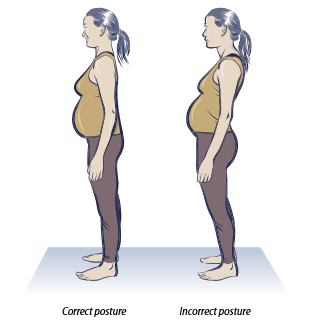
Your centre of gravity may shift forward as your uterus and breasts get bigger. This can cause a sway or arch in your lower back, and this way can cause your shoulders to slump forward. Poor posture can cause discomfort in your back, shoulders, and hips.
Pregnancy Back Pain
Is it normal to have back pain during pregnancy? Yes, absolutely. In fact, those lucky few who do not experience back pain at some point during their pregnancy are actually in the minority.
The American Pregnancy Association (APA) estimates that between 50% and 70% of women experience back pain in pregnancy.
Lower back pain may even be an early sign of pregnancy. It’s very possible that you may just be just five or six weeks pregnant and wondering what’s causing your lower back pain.
When Does Pregnancy Back Pain Set In?
Pregnancy back pain may show up early—as soon as the first trimester. At this point, your figure is unlikely to have changed all that much.
But major hormonal changes that make your soft tissues laxer are well underway. Thus, hormone changes are often to blame if you are just 4, 5, or 6 weeks pregnant and dealing with lower back pain.
While lower back pain in early pregnancy can and certainly does occur, that is not the most common time for discomfort to set in. Back pain is most common (and most severe) during the third trimester when your baby is the largest.
The most common time for back pain to rear its ugly head is around the 18-week mark—roughly the midpoint of your pregnancy. This discomfort typically lingers or intensifies through the remaining 22 weeks.
This does not, however, mean you should simply strap in for five months of misery. There are things you can do to limit or even cure this pregnancy “symptom,” many of which can be done from the comfort of your home. More on that shortly…
Common Causes of Back Pain During Pregnancy
Generally speaking, APA says the following are to blame for back pain while pregnant:
- An increase in hormones makes your ligaments more flexible, reducing the stability of the pelvis and back. Over-mobility of these areas is often to blame for lower back pain during early pregnancy.
- Increasing your body weight by 25% to 30% in a short amount of time is a lot for the body to handle. This can lead to sore muscles, ligaments, etc.
- The added weight also shifts your center of gravity forward, stressing the tissues of the back.
- Many also change their posture to support the belly, leading to strain and pain in the upper and/or lower back. The pregnant lady waddle adds insult to injury.
- For some, simply being pregnant is stressful, plus those midnight trips to the bathroom interrupt sleep. This also takes a toll on the body.
Thankfully, back pain goes away quickly post-pregnancy for most women.
Check your posture during pregnancy throughout the day by:
- pulling in your abdominal muscles – think “belly button to the backbone”
- pulling your shoulders back and straightening your spine
- standing up straight and walking tall
Caring for Your Back during Pregnancy
Back pain is common later in pregnancy. Follow these tips for back safety and comfort:
- keep good posture
- don’t lift heavy objects
- lift with your legs and not your back by bending your knees
- hold the object you are lifting close to your body
- do not twist when lifting
- keep your knees slightly bent but not locked when standing
- “log roll” when getting up from a lying position (turn onto your side and push up with both arms)
- rest and sleep on your side and put a pillow between your knees to support the upper leg
- avoid moving large objects
- If standing for long periods of time, put one foot on a stool
- wear comfortable, supportive shoes

